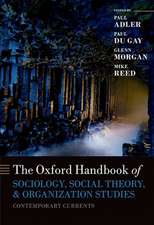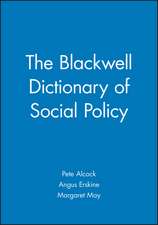Harmful Societies – Understanding Social Harm: Studies in Social Harm
Autor Simon A. Pembertonen Limba Engleză Paperback – 22 mar 2016
The notion of social harm is currently being explored as an alternative field of study within criminology, but the definition of social harm, the question of responsibility, and the methodologies for studying harm remain undeveloped. In the first book to theorize and define the social harm concept beyond criminology, Simon Pemberton addresses these omissions and, in doing so, provides a platform for future debates. Using case studies of various international regimes, he analyzes policy responses to different forms of social harm and provides a new typology of countries according to their harm prevention policies.
Preț: 206.77 lei
Nou
Puncte Express: 310
Preț estimativ în valută:
39.58€ • 41.16$ • 33.16£
39.58€ • 41.16$ • 33.16£
Carte disponibilă
Livrare economică 20 februarie-06 martie
Livrare express 05-11 februarie pentru 22.22 lei
Preluare comenzi: 021 569.72.76
Specificații
ISBN-13: 9781847427953
ISBN-10: 1847427952
Pagini: 224
Dimensiuni: 156 x 234 x 12 mm
Greutate: 0.32 kg
Editura: Bristol University Press
Seria Studies in Social Harm
ISBN-10: 1847427952
Pagini: 224
Dimensiuni: 156 x 234 x 12 mm
Greutate: 0.32 kg
Editura: Bristol University Press
Seria Studies in Social Harm
Notă biografică
Simon Pemberton is a Birmingham Fellow jointly appointed to the Schools of Law and Social Policy at the University of Birmingham, UK.
Cuprins
List of tables and figures
List of abbreviations
About the author
Acknowledgements
Foreword by Christina Pantazis
1. Introduction
Origins of ‘social harm’: the story so far…
Outlining the parameters of a social harm
Outline of the book
2. Defining social harm
Historical development of the social harm approach
‘Socially mediated’ harm
How do we discern between harms and non-harms?
Limitations of the needs-based approach
Conclusion
3. Capitalist formations and the production of harm
Harmful features of capitalism
Varieties of capitalism, varieties of harm production?
Harm reduction regimes
Harmful associations: regime types and harm indicators
Conclusion
4. Hard reduction regimes and the production of physical harm Homicide
Suicide
Infant mortality
Obesity
Road traffic injuries
Conclusion
5. Harm reduction regimes and the production of autonomy and relational harms
Relative poverty
Child poverty
Financial insecurity
Long working hours
Youth unemployment
Social isolation
Conclusion
6. Harm reduction regimes, neoliberalism and the production of harm
Developing a more systematic lens?
Capitalist harm: varieties of harm production?
Harmful societies…and less harmful capitalism societies?
Resurgent neoliberalism, enduring capitalism…What does the social harm perspective offer?
References
Index
List of abbreviations
About the author
Acknowledgements
Foreword by Christina Pantazis
1. Introduction
Origins of ‘social harm’: the story so far…
Outlining the parameters of a social harm
Outline of the book
2. Defining social harm
Historical development of the social harm approach
‘Socially mediated’ harm
How do we discern between harms and non-harms?
Limitations of the needs-based approach
Conclusion
3. Capitalist formations and the production of harm
Harmful features of capitalism
Varieties of capitalism, varieties of harm production?
Harm reduction regimes
Harmful associations: regime types and harm indicators
Conclusion
4. Hard reduction regimes and the production of physical harm Homicide
Suicide
Infant mortality
Obesity
Road traffic injuries
Conclusion
5. Harm reduction regimes and the production of autonomy and relational harms
Relative poverty
Child poverty
Financial insecurity
Long working hours
Youth unemployment
Social isolation
Conclusion
6. Harm reduction regimes, neoliberalism and the production of harm
Developing a more systematic lens?
Capitalist harm: varieties of harm production?
Harmful societies…and less harmful capitalism societies?
Resurgent neoliberalism, enduring capitalism…What does the social harm perspective offer?
References
Index
Recenzii
“Pemberton’s groundbreaking volume provides a major step forward in understanding the causation and alleviation of widespread harm.”
“In a sense, criminology has been ‘waiting’ for this original and highly topical book. It is of theoretical, conceptual, methodological, and empirical significance, making novel contributions in each respect.”
“The scope of this book is brave, almost breathtaking. . . . It is the scale and scope of what is attempted here that puts much criminology, and indeed much social science, in its place.”




















